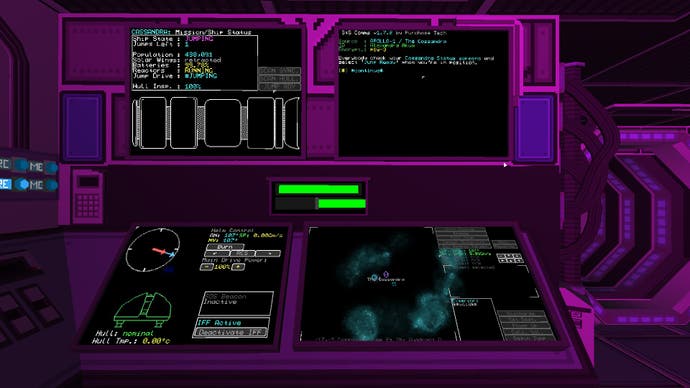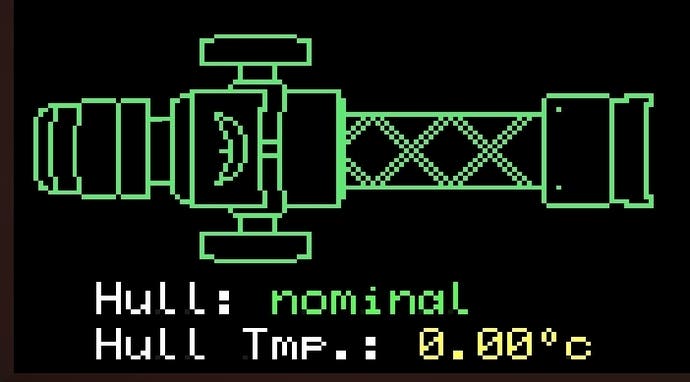Objects in Space is like Elite Dangerous without windows, and it's a charmer
Das Bootiful.
You can't do anything on one screen in Objects in Space. It's not a space game like Elite: Dangerous or Star Citizen, where you sit in a sleek cockpit with every control at your fingertips. In Objects in Space you have to get up and move around. The map is on one terminal, comms on another, emails another, battery management another, repairs another... It's as if you're flying an old submarine, where there are different panels and buttons for everything. Only here, you do it all alone.
There's tactility because of it. You make repairs by unscrewing panels, lifting the lid, swapping components, closing the lid, rescrewing the panel and reconnecting the component to see if it works again. You hear the clack of a keyboard while arrowing through the news or emails, echoing the noise your own PC keyboard is making. And you press big dramatic buttons to do big dramatic things, like put your ship into EmCon (emissions control) mode to make yourself as space-invisible as craft and components allow - shutting off engines, comms, thrusters, anything which could emit a scannable trace in the void. Even your music player.

It looks as retro as it sounds. You never see outside space-action in 3D, the way other games show it. Here, it unfolds as small pixelated blobs flying around a 2D map. What the outside of your ship looks like you can only imagine; all you ever see are interiors, which you move through one screen at a time - either on your ship or on the space stations you dock at for cargo, repairs, passengers or supplies. The characters you do see are starkly polygonal, pulled from an early era of 3D, and all the conversations you have - almost all of your interactions with the game, really - are handled chunky via old-school text.
And yet somehow, Objects in Space manages to pack a lot of charm. Naturally some of it comes from the nostalgic look and design, but more comes from the wit of the writing. There's a surprising amount here, reeled off in news reports and emails aboard your ship, or in dialogue interactions face-to-face or over comms. And I tell you, Objects in Space isn't afraid to speak its mind.

When the game begins, for instance, you are on the cusp of finishing a humanity-saving expedition to the Apollo system, to establish a jump-gate there and warp everyone to a glorious new home, and you're having a final giddy conversation with your commanding officer about the implications. Me being me, I told her I was worried humans would fudge everything up again, to which my commanding officer replied: "You can't hold modern humans accountable for the entire mess we inherited. We did the best we could to clean up after the colossal fuckwits who came before us." I nearly snorted out my tea.
Then mere moments later, after your fateful final jump goes terribly awry, and you're talking to someone you really hadn't expected, you ask after the whereabouts of lead ship Cassandra. "The Cassandra?" the other person replies. "Are you high?" To which I reply: "No! Well, maybe a little, but that's not why I'm asking."
It's a delightfully free-spirited way of talking which flows wonderfully through all interactions in the game. It's a lively and eccentric ensemble you'll come across here.

These bursts of personality help rescue Objects in Space from sinking into tedium - and it veers painfully close. Flying around, fetching and carrying, especially for trivial sums, can be dull. I suppose it has the natural effect of pushing you towards more exciting illegal missions, but even then, finding your way can take a while, and the back and forth can wear you down - especially if there's a bug and someone you need to talk to doesn't load, prompting you to fly around in circles trying to work out what to do.
Even the moments of respite on space stations can begin to look very samey. They don't vary a great deal and they're terribly lit, so dark as to hide character's faces and make it difficult to see whether someone's there at all. What's more, it's usually only one or two people you can interact with per station, which leaves the rest of your activity there - trading, repairing, buying, collecting missions - to be handled by, you guessed it, terminals.
But then, Objects in Space is a wide-open game made by two people - siblings Elissa and Leigh Harris (both writers, coincidentally) - so perhaps it's understandable and forgivable. And the occasional bumpiness? In some ways it suits it.
Nevertheless, Objects in Space requires patience and tenacity - it's old-school 90s in that way too. It plonks you in and says 'go make a name for yourself', and the challenge - the thrill - is in working out how. There's help and the introduction is gentle, but at some point you'll probably find yourself a bit lost, at which point I suggest leaning on one of the very helpful guides out there.
If you can settle in, Objects in Space can be very rewarding. Sneaking through nebula clouds while trying to avoid the pirates swarming nearby can be powerfully tense - and there's nothing like the sound of alarms and sight of flashing red lights to stoke the heartbeat when things go wrong (especially if you know you're the one doing repairs). Given time, Objects in Space will grow on you, charm you. But if you're after something a bit more immediate or mindless, it probably won't.










